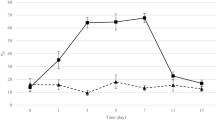Abstract
Saccharomyces boulardii (Sb) is a nonpathogenic yeast used to treat intestinal illnesses such as pseudomembranous colitis and antibiotic associated diarrhea. The behavior of this biotherapeutic agent in humans was determined (1) in investigating the effect of dose on the steady-state level and recovery and (2) in quantitating the effect of ampicillin on the recovery and elimination profile. As the Sb dose increased, the mean steady-state concentration of Sb increased significantly. The percentage recovery was dose independent. When a single Sb dose was administered 24 hr after beginning a course of ampicillin, there was a significant increase (P < 0.01) in both the area under the concentration versus time curve and the maximum fecal concentration compared to values obtained without ampicillin. Ampicillin increased steady-state recovery of the drug about twofold (P < 0.05) and steady-state levels about 2.4 times (P < 0.01). These studies have shown that there is a relationship between the dose and the amount of Sb recovered and that perturbation of the GI flora by ampicillin increases steady-state levels of Sb.
Similar content being viewed by others
REFERENCES
R. Fuller. Probiotics in human medicine. Gut 32:439–442 (1991).
D. Seal, S. P. Borriello, F. Barclay, A. Welch, M. Piper, and M. Bonnycastle. Treatment of relapsing Clostridium difficile diarrhoea by administration of a non-toxigenic strain. Am. J. Clin. Microbiol. 6:51–53 (1987).
H.-K. Harms, R.-M. Bertele-Harms, and D. Bruer-Kleis. Enzyme-substitution therapy with the yeast Saccharomyces cerevisiae in congenital sucrase-isomaltase deficiency. N. Engl. J. Med. 316:1306–1309 (1987).
S. L. Gorbach, T. W. Chang, and B. R. Goldin. Successful treatment of relapsing Clostridium difficile colitis with Lactobacillus GG. Lancet 2:1519 (1987).
C. M. Surawicz, L. V. McFarland, G. Elmer, and J. Chinn. Treatment of recurrent Clostridium difficile colitis with vancomycin and Saccharomyces boulardii. Am. J. Gastroenterol. 84:1285–1287 (1989).
M. B. Kimmey, G. W. Elmer, C. M. Surawicz, and L. V. McFarland. Prevention of further recurrences of Clostridium difficile colitis with Saccharomyces boulardii. Digest. Dis. Sci. 35 (7):897–901 (1990).
H. Blehaut, J. Massot, G. W. Elmer, and R. H. Levy. Disposition kinetics of Saccharomyces boulardii in man and rat. Biopharm. Drug Dispos. 10:353–364 (1989).
A. V. Boddy, G. W. Elmer, L. V. McFarland, and R. H. Levy. Influence of antibiotics on the recovery and kinetics of Saccharomyces boulardii in rats. Pharm. Res. 8:796–800 (1991).
R. D. Toothaker and G. W. Elmer. Prevention of clindamycin-induced mortality in hamsters by Saccharomyces boulardii. Antimicrob. Agents Chemother. 26:552–556 (1984).
C. M. Surawicz, G. W. Elmer, P. Speelman, L. V. McFarland, J. Chinn, and G. van Belle. Prevention of antibiotic-associated diarrhea by Saccharomyces boulardii: A prospective study. Gastroenterology 96:981–988 (1989).
C. E. Nord and C. Edlund. Impact of antimicrobial agents on human intestinal microflora. J. Chemother. 2:218–237 (1990).
S. Pecquet, D. Guillaumin, C. Tancrede, and A. Andremont. Kinetics of Saccharomyces cerevisiae elimination from the intestines of human volunteers and effect of this yeast on resistance to microbial colonization in gnotobiotic mice. Appl. Env. Micro. 57:3049–3051 (1991).
B. R. Goldin, S. L. Gorbach, M. Saxelin, S. Barakat, L. Gualtieri, and S. Salminen. Survival of Lactobacillus species (strain GG) in human gastrointestinal tract. Digest. Dis. Sci. 37:121–128 (1992).
G. W. Elmer and G. Corthier. Modulation of Clostridium difficile induced mortality as a function of the dose and the viability of the Saccharomyces boulardii used as a preventative agent in gnotobiotic mice. Can. J. Microbiol. 37:315–317 (1990).
Author information
Authors and Affiliations
Rights and permissions
About this article
Cite this article
Klein, S.M., Elmer, G.W., McFarland, L.V. et al. Recovery and Elimination of the Biotherapeutic Agent, Saccharomyces boulardii, in Healthy Human Volunteers. Pharm Res 10, 1615–1619 (1993). https://doi.org/10.1023/A:1018924820333
Issue Date:
DOI: https://doi.org/10.1023/A:1018924820333




